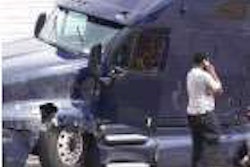Kenworth tractor excels in regional short-haul test
It’s no exaggeration to say that I learned to drive on U.S. Highway 82 running from Tuscaloosa, Ala., to Greenwood, Miss. It was on the flat, lonely stretch of old “Blues Highway” 7 running from Greenwood to Belzoni that I learned to drive fast – but that’s another story.
A lot has changed on Highway 82 since then. The highway is four lanes now in most places, so it’s a lot safer than it used to be. There’s also a lot more industry and urban sprawl visible today – gambling has been good to Mississippi. And now, just west of Columbus, Miss., you’ll see a brand-new Paccar engine plant standing on what used to be a plot of prime farm and hunting land.
I’d driven through a particularly violent thunderstorm on my way to the Paccar plant early one morning on my way to a Kenworth ride-and-drive event. But now the rain was dissipating, and the sun was making a half-hearted effort to break through the clouds. And in the rain-slicked parking lot behind the plant, I was getting ready to take a brand-new cobalt blue Kenworth T440 for an extended test drive. This particular T440 was equipped in a regional haul configuration with a 38-inch Aerocab sleeper, a Cummins ISL9 diesel engine and an Eaton 10-speed manual transmission.

This test-drive Kenworth T440 was equipped in a regional haul configuration with a 38-inch Aerocab sleeper, a Cummins ISL9 diesel engine and an Eaton 10-speed manual transmission.
It’s clear from the moment you climb up into the cab that Kenworth’s engineers spent a lot of time focused on driver comfort and ergonomics. Visibility to the front, sides and rear is outstanding, and every dial, switch and control in the cab is within easy reach. Sound dampening also is first-rate; the Cummins ISL9 isn’t a particularly loud diesel engine anyway, but in the T440, engine and roadway noise are muted to an astonishingly high degree for a commercial vehicle.
Company engineers are devoted to driver comfort.
Once I cleared the plant and merged onto Highway 82, I headed toward Greenwood. There’s a Pilot truck stop on the western edge of Winona, Miss. (near I-55), that would be a perfect place to turn around and head back to Columbus. The weather never improved, but on the road, I was struck by how comfortable and easy the truck was to drive. Steering was tight, even though the roads were slick with patches of standing water.
I’ve always felt you can tell a lot about a company’s designs and engineering philosophy by the amount of interior noise you get at highway speeds. To my mind, loose paneling and trim rattling and popping as you roll down the highway is a sign that somebody wasn’t paying attention to details and makes you wonder what else is loose under the hood or vibrating away down in some dark corner in the chassis. Happily, there was no residual noise present in my demo T440. My test run to Winona and back – exactly the sort of regional short haul for which this truck was designed – left nothing to be desired.
After lunch, a tour of the new engine plant was on tap. The plant is as modern as it’s possible for such a facility to be: Lasers cut parts, robots deliver components or seamlessly paint body surfaces, and everything is double-checked by an array of computers at almost every single work station. And all of that activity is backed up by a highly skilled work force dedicated to getting it right the first time.
After touring the facility, you understand that trucks like Kenworth’s T440 don’t just appear by happy accident. A lot of work, devotion and cross-checking goes into each and every component, system and structure that ultimately comes together to make up a complete Kenworth truck. And that’s a philosophy that shines through when you’re behind the wheel of one – even if it’s during a rain-soaked thunderstorm in the middle of Mississippi.
JACK ROBERTS is Executive Editor of Commercial Carrier Journal. E-mail [email protected] or call (205) 248-1358.













